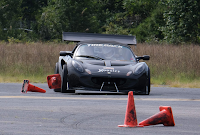As June rolled around plans to re-start racing were afoot, but soon so was a second surge in COVID-19, and a lot of uncertainty. For most of June and early July I basically ignored my build. My life has me with just 1 degree of separation from some 95 and 100 year old people, and in contact with others that have reason to believe COVID-19 would be particularly hard for. So even if some folks were racing, I couldn't in good conscience go hang out with 50+ other people.
By August things seemed to have remained stable at a low level in Massachusetts with just a few hundred cases state wide for a while. Additionally several races had been held by several clubs without any of them making the national news cycle as super-spreader events. Thus I began to have some hope that racing could be done safely. I started to work towards getting things put back together. Back in April, I had had a mix-up with ordering heater hoses, and that had to be resolved, which since it involves a lotus parts order took several weeks. Also I had to figure out how to get the harmonic balancer installed. This was complicated somewhat by the extra gear pasted on the front of it to drive the new oil pump.

The fitment was just a little too tight for me to feel comfortable pushing it on by hand, even though that was supposedly how it was supposed to go. For whatever reason it felt sticky and I *just know* that if I pushed it I'd probably give it uneven pressure and cause it to dig in and gall things up. It was one of those cases where I had that all too familiar feeling that I was about to ignore my instincts and then immediately regret it (much like that feeling when the torque wrench isn't beeping, but the nut feels like its going to strip... and you trust the wrench only to later realize it was set to ft. lbs not Nm... yeah...). So I took a deep breath and... stopped before I screwed it up.
Of course, the crank has a M12 1.25 mm fine threaded bolt, which is a size that exists in exactly NONE of the harmonic balancer installation tool kits out there. In the end I made my own ordering threaded rod, nuts, washers and a bearing from McMaster Car
Clearly not a solution for tight spaces, but when the engine is dangling from a crane, it works just fine. With this and a just a fine skimmer of light oil, it went right on with no fuss. Then I discovered the bolt that had been sent with it was 8.8... and factory torque says 120Nm... nope. So order a
better bolt from Belmetric.
And somewhere along the line the aluminum underdrive pulley for the alternator had gotten dinged, and had to be replaced... but the alternator nut and hex drive shaft proved a challenge. I wound up ordering a Schwaben 22mm offset open end wrench allegedly specifically designed for alternator nuts. Simple, right? A wrench is a wrench, right? But when it arrived it didn't actually fit! It was 22mm per my calipers, the nut was 22mm per the same calipers, but the corners in the wrench were slightly too rounded... Really Schwaben? you only had one job to do here... only one thing to get right that actually mattered.... (No link for you!) So since I'd been going through a parade of deliveries, loosing 1-4 days each time I took a file to it and "Made it fit damnit!"... and that worked just fine as, if only as a 6 point rather than 12 point.
So at that point my heater hose finally arrived, and suddenly there was nothing blocking any re-assembly of the front of the car, and also I installed the new Stack Oil pressure gauge, and unblocked the re-assembly of the interior... The number of pieces of my car in the garage was now back ahead of the number in my basement!
Visible Progress! In the forward direction no less!... but then... I found a reason to take the intake manifold off the engine... That's the subject of the next post...






